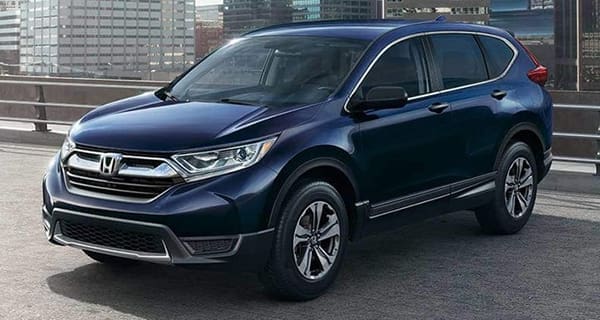
The CR-V has long been a winner for Honda. And the 2019 version maintains the qualities that set it apart: driver-friendliness, usability, thrift, and driveability
 Although I drive 50 to 60 new cars a year, I still own a 1976 BMW 2002, a ’76 Triumph TR6 and the family schlepper: a 2002 Honda CR-V.
Although I drive 50 to 60 new cars a year, I still own a 1976 BMW 2002, a ’76 Triumph TR6 and the family schlepper: a 2002 Honda CR-V.
The first two cars are my toys, pampered and driven in nice weather, and usually for short distances.
The Honda is the workhorse, and is used day-in, day-out, fair weather or foul. It has almost 250,000 km on it and is as reliable now as the day it rolled off the assembly line.
There have been a few issues – emergency/rear brake overhaul, crankcase ventilation valve replacement and a few other odds and ends – but considering the mileage it racks up and lack of respect it gets, it has been a paragon of dependability.
I don’t spend a lot of time thinking about our old CR-V. I just drive it, which is still a pleasure, incidentally.
The qualities that made the CR-V such a winner for Honda – driver-friendliness, usability, thrift, and driveability – are still very much in evidence in the newest iteration of this Honda mainstay. I recently spent some time with the 2019 CR-V and liked just about everything about it.
Available in five trim levels, with front or all-wheel-drive, the CR-V is powered by a 1.5-litre four-cylinder mated to a continuously variable transmission (CVT). While the engine is an absolute marvel of engineering, the CVT is the car’s biggest drawback.
Considering its relatively small size, the engine in the CR-V is kind of remarkable. At just over a litre and a half, it develops some 190 horsepower, thanks to a turbocharger. I love this little power plant – it’s responsive, well-behaved, almost silent in operation and, with a combined fuel economy rating of 8.0 litres/100 km, reasonably cheap to run.
No one builds better small displacement engines than Honda (it’s how the company got started), and the CR-V continues the tradition.

The 2019 Honda CR-V has uncomplicated switchgear and ergonomics. And it has excellent storage space.
However, the transmission is a mess. It’s unresponsive, vague and lacking enough bite to match this vehicle’s comparatively small power plant.
Were I in the market for a compact sport utility vehicle, the CR-V and its accompanying CVT would be a deal-breaker for me. In every other way, the CR-V is the benchmark of this market segment, but the CVT lets it down at virtually every turn. It robs the engine of any kind of power, seems to take forever to spool up and makes parking much more complicated than it should be.
For example, if I’m parallel parking on a busy street, I want the car to click into reverse immediately – not waffle around while it makes up its mind and then suddenly lurch into gear. That’s really really annoying.
That said, there is an “econ” button that almost functions as an overdrive. Press this console-mounted button and performance – such as it is – goes out the window. Release it and you get a bit more snap and get up and go. I just left it in the off position.
The CR-V has excellent storage space. Fold down the back seat and you get some 2,146 litres (59 cubic feet) of cargo area. This beats just about everything else in this category, including the Toyota RAV4, Mazda CX-5 and Hyundai Santa Fe. Full marks here.
And, if you overlook the awful CVT, it’s a pleasure to drive. One of the things that cemented the original model’s popularity was its sheer driveability and easy-to-get-along-with nature.
The 2019 iteration is no different, and I grew to appreciate its uncomplicated switchgear and ergonomics. Unlike some of Honda’s other products – the Acura MDX, for example, which is virtually undriveable – the CR-V presents no obstacles when it comes to figuring out how things work and making the cabin comfortable and useable.
Honda seems to have lost its way in the ergonomics/switchgear department with many of its offerings. Thankfully that hasn’t happened to the CR-V … yet.
In short, this is a state-of-the-art compact sport utility vehicle at the head of the class in every department, except for its transmission, which changes everything.
Too bad the company doesn’t offer a non-CVT model.
2019 Honda CR-V
Engine: 1.5-litre turbocharged four cylinder
Transmission: Continuously variable transmission
Drive: Front-wheel, all-wheel
Horsepower: 190 at 5,600 rpm
Torque: 179 foot pounds at 2,000 to 5,000 rpm
Price range: $27,690 to $39,090
Fuel economy: 8.7 litres/100 km city and 7.2 highway, with regular gas
Some alternatives: Toyota RAV4, Mazda CX-5, Ford Escape, Nissan Rogue, Kia Sorento, Hyundai Santa Fe, Volkswagen Tiguan, Chevrolet Equinox.
Ted Laturnus writes for Troy Media’s Driver Seat Associate website. An automotive journalist since 1976, he has been named Canadian Automotive Journalist of the Year twice and is past-president of the Automotive Journalists Association of Canada (AJAC).
The views, opinions and positions expressed by columnists and contributors are the author’s alone. They do not inherently or expressly reflect the views, opinions and/or positions of our publication.

